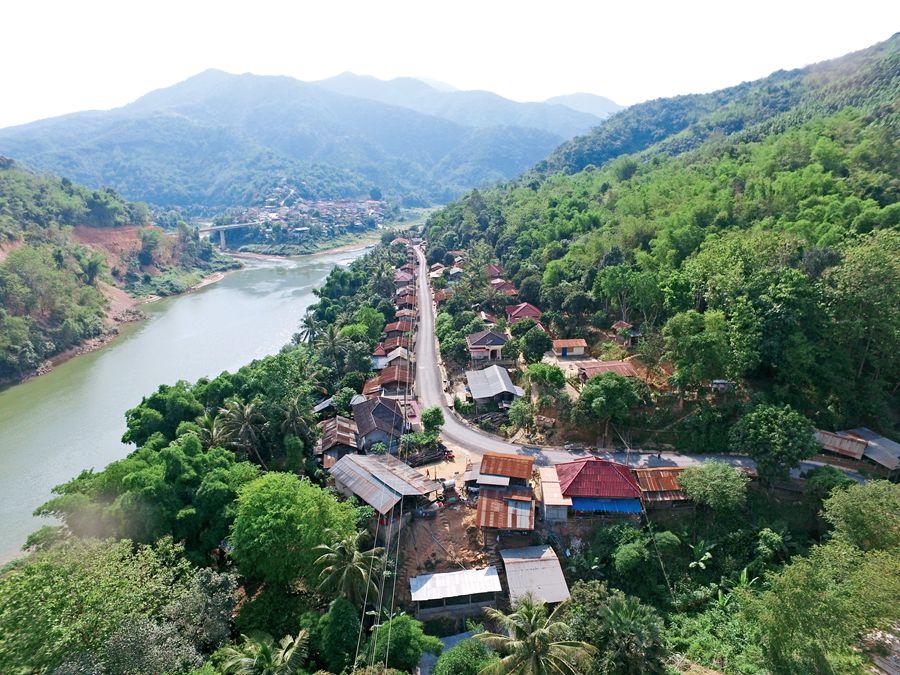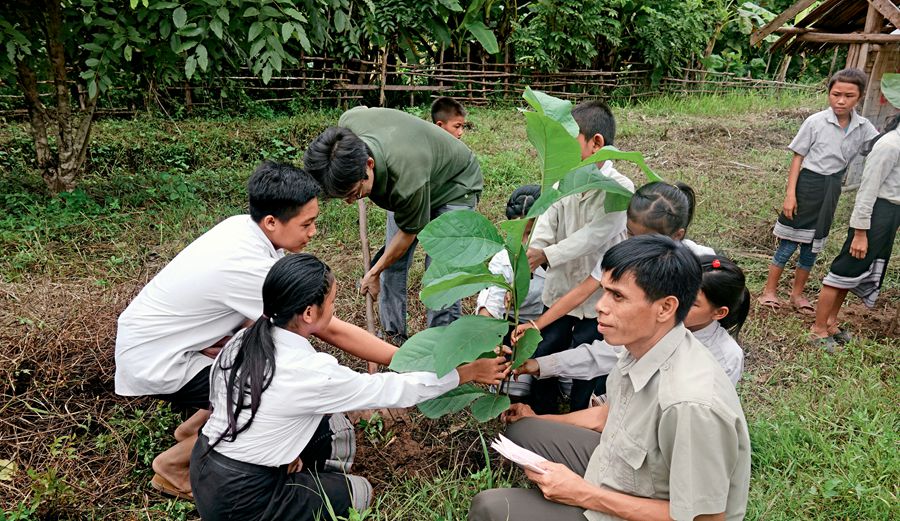ON May 14, 2017, Chinese President Xi Jinping delivered a keynote speech at the opening ceremony of the Belt and Road Forum for International Cooperation, stressing that “We should uphold the concept of green development, advocate a low-carbon, recyclable and sustainable life style, and strengthen ecological cooperation to make it a part of our life so that we can join hands in achieving the United Nations Sustainable Development Goals by 2030.” Throughout these years, the green development idea has earned worldwide recognition and such collaborations along the routes of the Belt and Road Initiative (BRI) are thriving.
A Natural Bond
Originating from the Tanggula Mountains on the Qinghai-Tibet Plateau, the Lancang-Mekong River runs southward through the Yunnan-Guizhou Plateau onto the Indo-China Peninsula, nurturing hundreds of millions of residents in the river basin. Since ancient times, the Chinese and Laotian peoples living on both sides of the river have been connected closely. Nam Ou River, the largest tributary of the Mekong River on its west bank in Laos, flows 475 kilometers southward to Luang Prabang Province, with a drainage area of 256,000 square kilometers. With an approximately 430-meter-high natural drop and excellent water indices, it is one of the hydropower resources exploited by the Laotian government.

At the level-4 station of the Nam Ou Cascade Hydropower Project, PowerChina has rebuilt the roads leading to the counties at the lower reaches of the river and improved the traffic conditions of surrounding communities.
“Laos and China are neighbors linked by adjoining rivers and mountains. Laos, rich in hydropower resources, aims to build itself into the ‘battery of Southeast Asia’ which echoes the Belt and Road Initiative proposed by Chinese President Xi Jinping. Hence, Laos’ Nam Ou River Cascade Hydropower Project and its branding play a significant role in enhancing connectivity and infrastructural cooperation between China and ASEAN,” said Bounpong Ketsadasak, a Laotian employee of the Power Construction Corporation of China, or PowerChina. In 2008, Ketsadasak resigned from Electricite Du Laos and joined PowerChina when the latter was building the Nam Ngum 5 Hydropower Station on the Nam Ting River in Laos. A decade passed by, and he has already become a veteran employee of PowerChina who participated in the whole relocation process of local residents for the Nam Ou project and is now responsible for the marketing of electric power for the hydropower station.
“Nam Ou hydropower project is the first overseas investment by a Chinese company under the build-operate-transfer (BOT) model. The project was designed to comprise seven separate cascade power stations in order to halve the submerged areas, reduce the number of people being relocated, and minimize the losses of arable land and woodland. With water resources at seven cascades being under unified management, the power generation capacity at Nam Ou will not be affected in dry season,” said Ketsadasak.
Pearls Dotting the Green Silk Road
Laos’ national strategy is to become the hydroelectric battery of Southeast Asia and to get rich through developing hydropower. This policy has attracted the interests of power enterprises from countries including China, Thailand, Malaysia, France, and Japan. Of these companies, PowerChina was eventually granted the development rights of the entire Nam Ou River by the government of Laos.

The level-3 station of the Nam Ou project plants trees at the local campus for the rural, disadvantaged students.
Competitors for the Nam Ou hydropower project emerged as early as in 1995 when an American company designed two large reservoirs with high dams. This plan had the advantage of higher installed capacity and easy management, but would result in a large submerged area, large scale of relocation, and serious damages to environment. PowerChina set eyes on the Nam Ou project in 2005. Taking its advantage in hydropower planning and designing, it put forward a seven-hydropower-dam plan. By lowering the height of each dam, the plan strove for reducing the impact on local residents and surrounding ecology while raising the economic benefits.
Finally, the ecology-friendly two-phase development plan for the Nam Ou Cascade Hydropower Station won the Laotian government’s recognition among other options.
As Route 13, a well-known north-south highway in Laos, connects the Nam Ou-1 hydropower dam and the world famous tourist city of Luang Prabang, just 45 kilometers away from the station, large numbers of people are expected to visit the hydropower dam. As a result, the Laotian government set very strict environmental requirements on the construction of the project.
The Chinese ecological development concept that “lucid waters and lush mountains are invaluable assets” has been put into practice at every step and detail of the construction. Efforts have been made mainly in three aspects: First, all auxiliary projects are banned from making any damage to the original ecology; second, the aggregate processing system operates within an enclosed environment to prevent rising dusts; and third, all waste water produced during the construction process should be recycled and reused after passing through three sedimentation tanks and five drain pits to achieve zero discharge of sewage. Meanwhile, every key part of the domestic water facilities is installed with a water decomposer and a purification system device to ensure the quality of drinking water.
Valuable lessons also include the environmental impact assessment report compiled by PowerChina’s project department. The implementation of the project has strictly abided by the environmental laws and regulations of both Laos and China as well as the environmental liability provisions of the franchise agreement, following the principle of adhering to the highest standard.
Electrical Battery of Southeast Asia
Another large-scale hydropower station built simultaneously with the Nam Ou project is the Nam Phay Hydropower Project in Xaisomboun Province of Laos, which has been acclaimed as “a major project for livelihood” by the former Minister of Energy and Mines Khammany Inthirath.
The Nam Phay project, with a total investment of US $210 million, was jointly funded by China North Industries Corporation, or Norinco Group, and Electricite Du Laos. The project was completed and integrated on the National Energy Grid of Laos in November 2017. Laos’ national power transmission system comprises four regions. The Nam Phay Hydropower Station, located in the central 1 region, supplies electricity for the area including Vientiane, the capital of Laos, and Xaisomboun, that sees the largest power consumption in the country. It now contributes about 10 percent of the central 1 region’s total power supply, providing a steady guarantee for the economic development of Laos’ heartland.
A Laotian worker named Gaea from Luang Namtha Province is responsible for checking the instrument box at the Nam Phay station. He got the job after graduating from high school and received training in China. “Hydropower industry is the backbone of Laos’ economy. Here, I can learn about brand-new technology and skills and will then be able to make more contributions to my country’s development.”
Localized management has offered lots of job opportunities for local people and trained a large number of technicians and managerial personnel. At present, the ratio of Chinese and Laotian employees is 1:2 and it is expected that local people will make up 70 percent of the staff, meaning that more and more Laotians will be in the key managerial positions.
Voices of Migrants
PowerChina has done a good job in the relocation of local residents for the Nam Ou project. Its resettlement schemes have not only improved the living conditions of the relocated people but also help them quickly settle down.
In a tiny village near the Nam Ou-2 station, Ketsadasak recalled some stories. “Residents that once lived in the reservoir areas have moved from their shanties into spacious and bright new houses. The new village is equipped with such facilities as a school, infirmary, village administrative office, marketplace, and a temple where the villagers can hold religious activities. To help the relocated villagers return to their normal life quickly, the measures taken included building a 12-kilometer-long road for heavy farming machinery, teaching villagers how to plant coffee, and providing them with grain subsidies to facilitate a smooth transition. Outstanding students in the village were subsidized by PowerChina to further their studies in China’s Wuhan University.”
During the process of relocation and ecological restoration, NGOs are another force to be reckoned with. In September 2016, representatives from the U.S., Thailand, and China offices of International Rivers, a non-profit organization, chose the Nam Ou-6 dam project for an on-site investigation regarding its environmental protection, relocation of residents, community development, and profit-sharing mechanism.
Stephanie Jensen-Cormier, China Program Director of International Rivers, posed an incisive question: The local residents are often promised to have working opportunities before the relocation, but they may not need a modern life or a salary to feed the family.
In a response, Director of the first phase of the Nam Ou Cascade Hydropower Project Song Huihong said frankly, “International Rivers is an organization which rejects the building of dams, while PowerChina builds dams. Naturally we are a contradictory pair. Therefore, it is important for us to keep an open and inclusive attitude towards each other. There is no doubt that the environment of rivers will be changed because of the dam construction, what we need do is to reduce the harm and protect it as possible as we can by means of advanced technologies and proper use of funds. Rather than keeping a distance from international organizations, we opened our door and let them know what we had actually done.”
Openness and communication have allowed the specialists to see the real results concerning the reservoir environment, ecology, and settlement of the relocated people. The maintenance of water quality, vegetation protection, and improvement of the migrants’ living conditions have all reached the expected goals, thus gaining recognition from International Rivers.
The Nam Ou River Cascade Hydropower Project is just a little epitome of sustainable development along the routes of the Belt and Road. At the 2018 meeting of the China Council for International Cooperation on Environment and Development, China announced the establishment of the International Coalition for Green Development on the Belt and Road, aiming to promote the building of a green Silk Road to be an international consensus and a joint action, and to fully implement the UN 2030 Agenda for Sustainable Development. So far more than 80 organizations have joined the coalition as partners. Along with the advancement of various projects under the BRI and a global recognition of the green development concept, the huge demand and development potential of the green Silk Road will be gradually realized.

